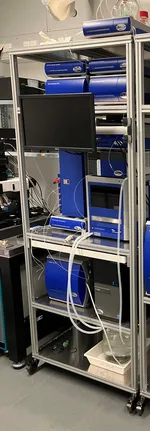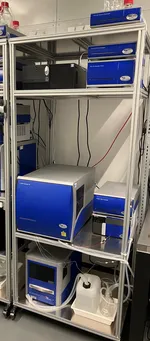EQUIPMENT: FIELD FLOW FRACTIONATION
Asymmetric Flow Field Flow Fractionation AF2000

(Postnova Analytics GmbH, Germany)
Detectors:
- Multiangle light scattering (MALS, PN3621, 21 angles) for molecular weight and particle size determination. 21 Angles allow for improved size determination, especially for larger particles.
- UV-Vis (PN3211)
- Raman flow cell
The AF2000 is based on the asymmetrical flow field flow fractionation (AF4) principle, using a crossflow field as driving force for the separation. The samples, which are affected by this field, are separated by their hydrodynamic diffusion based on the molar mass or particle size. The AF4 is ideal for the characterization of proteins, antibodies, aggregates, vaccines, liposomes, nanoparticles and natural or synthetic macromolecules. In combination with a frit-inlet channel the system can also be used for very sensitive samples. For samples with low concentrations the smart stream splitter can be applied to improve sensitivity by a factor of two to five.
---
Centrifugal Field Flow Fractionation CF2000

(Postnova Analytics GmbH, Germany)
Detectors:
- Multiangle light scattering (MALS, PN3621, 21 angles) for molecular weight and particle size determination. 21 Angles allow for improved size determination, especially for larger particles.
- UV-Vis (PN3211)
- Raman flow cell
The CF2000 is based on the Centrifugal field flow fractionation (CF3) principle using a centrifugal field as driving force for the separation. Particles affected by this field are separated by diffusion on the basis of both the particle size and density. This unique feature allows the separation of different particle materials having the same particle size. Therefore, the CF2000 can be ideally used for separation of complex particle samples. The system is ideal for nanoparticles and is also suitable for the microparticle range, including various organic and inorganic particles.
---